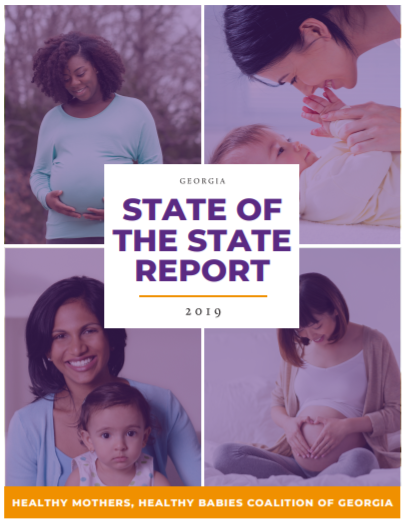Official Release: 2019 State of the State: Maternal and Infant Health in Georgia Report
Healthy Mothers, Healthy Babies Coalition of Georgia (HMHBGA) is excited to announce the release of the 2019 State of the State: Maternal and Infant Health in Georgia Report. The report is the third of its kind and is meant to share current knowledge and projected trends of maternal and infant health outcomes in Georgia, as well as what can be accomplished to further improve the health of mothers and babies. It is important to HMHBGA that is data be made publicly available to be used by practitioners, families, and advocates alike.
Data was collected from a number of sources including the Georgia Department of Public Health, Centers for Disease Control and Prevention, and the March of Dimes. Local content area experts were also consulted to provide the most updated statistics and current best practices when needed.
2019 State of the State: Maternal and Infant Health in Georgia Report Executive Summary
The 2019 State of the State: Maternal and Infant Health in Georgia Report summarizes the known data and evidence regarding maternal and infant health indicators in the state of Georgia. It is published by Healthy Mothers, Healthy Babies Coalition of Georgia, and this is the third edition of this report. The purpose of this report is to continue to share current knowledge and projected trends of maternal and infant health outcomes in Georgia, as well as what can be accomplished to further improve the health of mothers and babies. Primary sources of data were used when possible (e.g. Online Analytical Statistical Information System [OASIS], Pregnancy Risk Assessment & Monitoring System [PRAMS]), and further data analysis was conducted using IBM SPSS® and R. Additionally, content area experts were consulted to provide the most updated statistics, in addition to current best practices.

HMHBGA Research & Policy Analyst
“I think as researchers and practitioners, we often cite statistics around Georgia’s poor outcomes from so many sources and years, which can be confusing,” says Amber Mack, Research & Policy Analyst with HMHBGA. “The State of the State places these Georgia-specific facts and figures in one report that is easily accessible to anyone that needs it.”
Overall, we found that Georgia has made many positive strides in maternal and child health in the past decade, however there is still room for improvement. Georgia ranks high in TDaP and HPV vaccine uptake for children. However, flu vaccine uptake is below average for children, pregnant women, and adults, compared to national rates. Georgia is also a top performer in developmental screenings of children. Georgia’s breastfeeding frequency of initiation is slightly higher than the national average. However, the duration to the recommended six months of exclusive breastfeeding remains a challenge. Nationally, Georgia ranks in the bottom 10% for infant mortality, low birthweight, preterm birth, and maternal mortality. In 2017, the leading cause of infant death in Georgia was fetal and infant conditions, particularly prematurity. Georgia also experiences unintended pregnancy slightly above the national average. Finally, there are known disparities and inequities in Georgia by race, age, ethnicity, education, region, insurance status, etc. Black and African American women in Georgia experience worse maternal and infant outcomes than all other races and ethnicities.
In order to improve maternal and infant health in Georgia, we recommend evidence-based interventions in the following areas: (1) infant health, (2) prenatal/perinatal health, (3) maternal substance prevention, (4) neonatal abstinence syndrome, (5) maternal mental health, (6) maternal mortality prevention, (7) patient education, (8) increasing breastfeeding duration, (9) social support during prenatal and postpartum periods, (10) legislative advocacy, and (11) data collection and needs assessment.
Key Findings - Areas of Marked Improvement
- As of 2015, Georgia’s breastfeeding frequency of initiation was slightly higher than the national average. However, the duration to the recommended six months of exclusive breastfeeding remains a challenge.
- Georgia’s teen pregnancy rate for 2017 was slightly higher than the national average, but have continued to decrease over time.
- Georgia ranked highest (84.7%) in TDaP and HPV vaccine uptake in children in 2016 (national median is 73.2%).
- In regards to child-specific services, 94.4% of CHIP-enrolled children had a Primary Care Physician (PCP) visit at 12-24 months of age.
- Finally, Georgia is also a leader in screening children 0-3 years of age for developmental, behavioral, and social delays, with 52.1% of children enrolled in CHIP being screened (compared to the national median of 39.8%).
Key Findings - Serious Remaining Challenges
- The Georgia Maternal Mortality Review Committee found that 58% of pregnancy-related deaths in 2014 were preventable and that African American and Black women were 3-4 times more likely to die related to childbearing or postpartum complications.
- As of 2017, Georgia’s infant mortality rate ranked 6th highest in the nation.
- In both 2016 and 2017, Georgia ranked 4th highest in low birthweight nationally.
- As of 2017, Georgia ranked 5th highest in the nation for preterm birth rates (marginal increase from 2013 to 2017).
- As of 2015 in Georgia, the rate of neonatal abstinence syndrome in Georgia increased threefold from 2010.
- In 2011, the frequency of unintended pregnancy was 54.8% across Georgia, with large disparities by race.
- In Georgia, pregnant women ranked below the national average for flu vaccine uptake in 2017.

Executive Director
"We hope that policymakers, advocates, funders and the provider community will use the report recommendations as a blueprint for addressing our severely distressing maternal and infant health outcomes," says Elise Blasingame, Executive Director for HMHBGA.
"We need everyone on board to make a real impact for Georgia's mothers and babies. There are bright spots, but we have a long road ahead."

